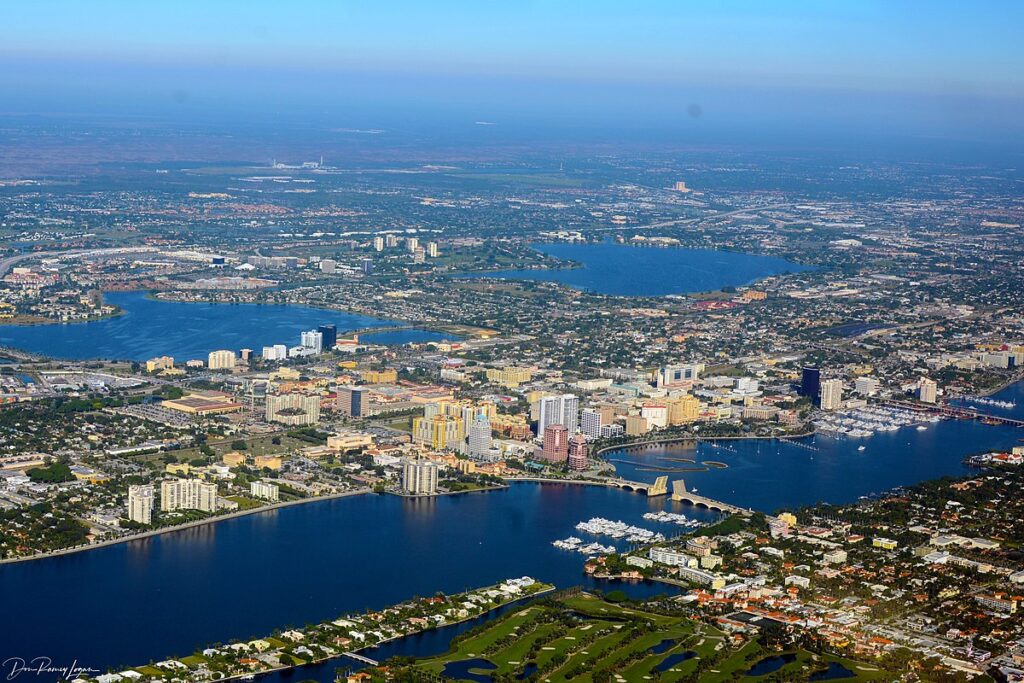
Moving to West Palm Beach, Florida: A Comprehensive Relocation Guide
Considering moving to West Palm Beach, Florida? This vibrant Palm Beach County city offers downtown revival, waterfront location, and cultural energy. With approximately 120,000 residents in 2025, West Palm Beach combines urban sophistication with beach access and South Florida’s booming metropolitan center.
Demographic Profile to Consider If Moving to West Palm Beach:
West Palm Beach’s 2025 population is approximately 120,000 residents, making it Palm Beach County’s largest city. The median age is around 38 years, with young professionals, diverse families, artists, and working residents. The population is approximately 45% White, 35% Black or African American, 18% Hispanic. West Palm Beach features a dramatically revitalized downtown with CityPlace, Clematis Street nightlife, waterfront parks along the Intracoastal Waterway, and diverse neighborhoods throughout. The city’s transformation from struggling downtown to vibrant urban center attracts young professionals and creatives. West Palm Beach combines urban energy with waterfront lifestyle. The community balances development with neighborhood character and cultural diversity. Find trusted local services for moving, living, and working in West Palm Beach.West Palm Beach Relocation Directory
Cost of Living to Consider If Moving to West Palm Beach:
West Palm Beach offers moderate to upper-moderate costs for Palm Beach County. Median home values range from $380,000 to $580,000 in 2025, varying dramatically by neighborhood from emerging areas to waterfront luxury properties. The median household income is approximately $58,000. Rental properties average $1,900 to $3,200 monthly. Florida’s absence of state income tax benefits residents. Overall cost of living reflects urban character and waterfront location. The city attracts diverse income levels from artists to affluent professionals. Housing costs vary significantly from revitalizing neighborhoods to established waterfront areas. Rapid growth and development drive increasing prices.
Economy and Job Market:
West Palm Beach’s economy is diverse and booming, including financial services, healthcare, technology, real estate, and tourism. Major employers include NextEra Energy (Florida Power & Light headquarters), Palm Beach County government and schools, hospitals including St. Mary’s Medical Center and Good Samaritan Medical Center, and numerous professional services firms. The city attracts financial companies and tech startups. The Norton Museum of Art and cultural sector provide employment. Real estate and construction support massive development. Many residents work in professional services, healthcare, finance, and hospitality. The broader Palm Beach County economy offers vast opportunities. Typical industries include finance, healthcare, technology, real estate, and professional services. The diverse economy provides opportunities across all sectors. The city ranks among Florida’s fastest-growing job markets.
Education:
The School District of Palm Beach County serves West Palm Beach students with numerous schools throughout the city. The large district offers magnet programs and choice schools. School quality varies dramatically, requiring family research. Palm Beach State College campuses provide associate degrees. Palm Beach Atlantic University offers private Christian education. The educational infrastructure serves the diverse population with varied quality requiring school-by-school evaluation.
Recreation and Lifestyle:
West Palm Beach offers revitalized downtown with CityPlace shopping and dining district, Clematis Street’s vibrant nightlife, and the waterfront Flagler Drive area. The Norton Museum of Art showcases world-class collections. The Kravis Center for the Performing Arts presents Broadway shows, symphony, and performances. Meyer Amphitheatre hosts outdoor concerts. The Palm Beach Zoo and South Florida Science Center provide family attractions. Residents enjoy the Intracoastal Waterway waterfront parks, fishing, and boating. Atlantic Ocean beaches in Palm Beach are minutes away. Professional sports include spring training baseball. The lifestyle emphasizes urban energy, arts, waterfront recreation, and nightlife. The tropical climate enables year-round outdoor activities. The community values development, diversity, arts culture, and urban sophistication. The downtown transformation creates dynamic city atmosphere.
Healthcare and Services:
West Palm Beach residents access comprehensive healthcare through St. Mary’s Medical Center, Good Samaritan Medical Center, Wellington Regional Medical Center, and extensive facilities throughout Palm Beach County. The region’s healthcare infrastructure is excellent with specialized care in all disciplines.
Transportation:
West Palm Beach benefits from Interstate 95, Florida’s Turnpike, and various corridors. Palm Beach International Airport serves the region with extensive domestic and international flights. Palm Tran operates bus routes throughout the city. Brightline high-speed rail connects to Miami and Fort Lauderdale. Downtown offers walkability along Clematis Street and the waterfront. Most residents use personal vehicles. Typical commute times vary throughout Palm Beach County.
Conclusion:
Moving to West Palm Beach in 2025 offers vibrant urban living with downtown revival, waterfront location, and cultural sophistication. The city’s combination of Clematis Street energy, Norton Museum arts, Intracoastal beauty, and booming economy makes it ideal for young professionals, diverse families, and urban dwellers seeking Palm Beach County’s metropolitan center where sophistication meets waterfront lifestyle and urban energy defines South Florida’s fastest-growing city.

